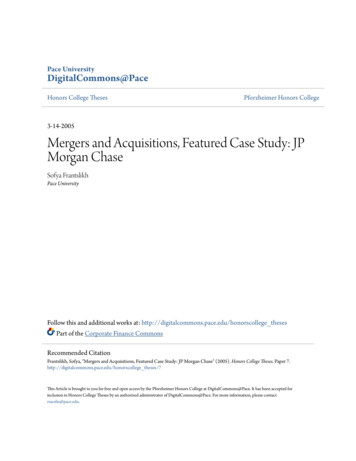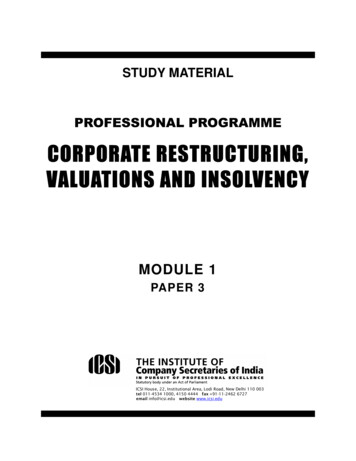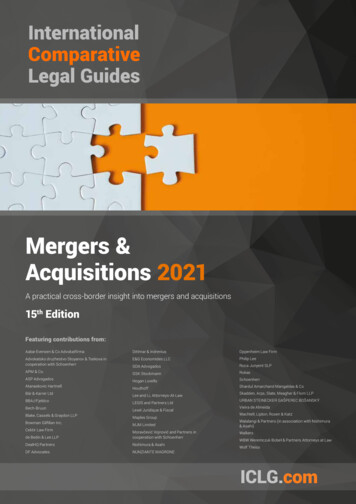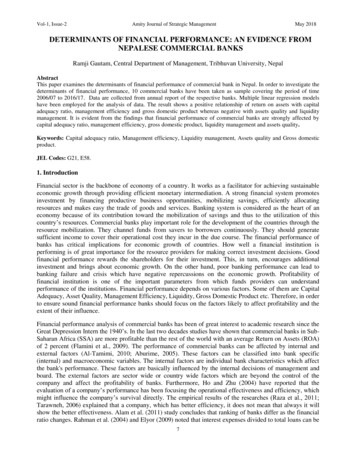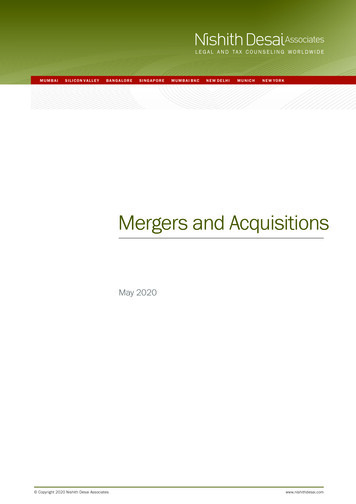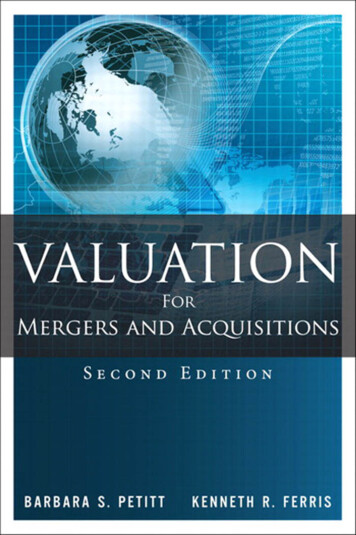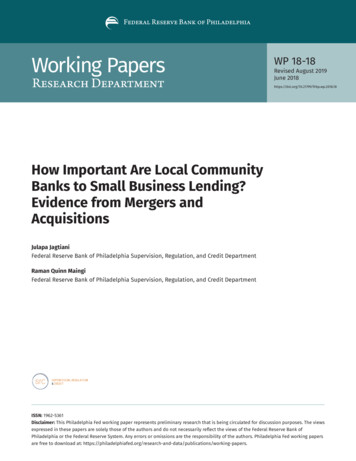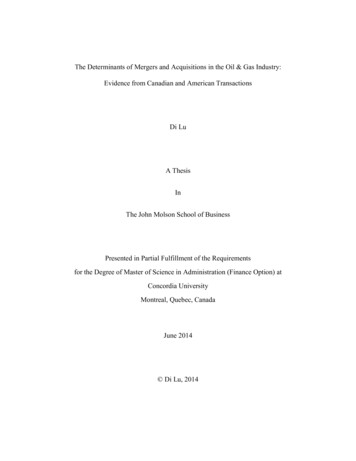
Transcription
The Determinants of Mergers and Acquisitions in the Oil & Gas Industry:Evidence from Canadian and American TransactionsDi LuA ThesisInThe John Molson School of BusinessPresented in Partial Fulfillment of the Requirementsfor the Degree of Master of Science in Administration (Finance Option) atConcordia UniversityMontreal, Quebec, CanadaJune 2014 Di Lu, 2014
CONCORDIA UNIVERSITYSchool of Graduate StudiesThis is to certify that the thesis preparedBy:Di LuEntitled:The Determinants of Mergers and Acquisitions in the Oil & GasIndustry: Evidence from Canadian and American Transactionsand submitted in partial fulfillment of the requirements for the degree ofMaster of Science in Administration (Finance Option)complies with the regulations of the University and meets the accepted standardswith respect to originality and quality.Signed by the final examining committee:ChairDr. Rustam VahidovExaminerDr. Nilanjan BasuExaminerDr. Saif UllahSupervisorDr. Sandra BettonApproved byChair of Department or Graduate Program DirectorDr. Harjeet S. BhabraDean of FacultyDr. Steve HarveyDateJune 30th, 2014
ABSTRACTThe Determinants of Mergers and Acquisitions in the Oil & Gas Industry:Evidence from Canadian and American TransactionsDi LuThe study investigates the determinants of mergers and acquisitions in the oiland gas industry over the ten-year period from 2002 to 2011. Our large sampleanalysis results indicate that in the O&G industry: (1) U.S. acquirers are largerthan Canadian acquirers overall; (2) value bidders generate greater abnormalreturns relative to glamour bidders in Canadian market; (3) the geographicalproximity of headquarters cannot generate pronounced synergies, and evendestroys penny stock bidder’s value; and (4) there is no mispricing effect in thepenny stocks, but they are more illiquid and have a higher level of idiosyncraticrisk. We also examine three cases in 2012-2013 to verify our results and toidentify several firm specific factors that are not considered in the large sampleanalysis. Consistent with our expectations, the Canadian transaction is morestraightforward whereas the U.S. transactions depend more on pre-existingconnections between the firms and suggest more corporate governance concerns.iii
ACKNOWLEDGEMENTSI would like to express my deep appreciation to the following individuals:-My supervisor, Dr. Sandra Betton, who supervised me in serious andprofessional attitudes, helped me with rich experiences in corporate finance,encouraged me by patient, instructed me to discover my research interests. Igreatly appreciate her valuable supports and enjoy the time we worked together.-My committee members, Prof. Nilanjan Basu and Prof. Saif Ullah, whogave me precious suggestions which helped me to improve this thesis.-My dear parents and friends who are always by my side and bring mepositive energy.iv
TABLE OF CONTENTSList of Tables . viiList of Figures . ix1.Introduction . 12.Literature Review and Hypotheses . 73.Data . 154.5.3.1.Global Market Structure . 153.2.North American Deals . 18Methodology. 244.1.Event Study Methodology. 244.2.Logistic Test . 274.3.Cross-sectional analysis . 294.4.Case Study Methodology . 31Results of Large Sample Analysis . 325.1.Basic Event Study . 325.2.Marginal Effects of Deal Completion and Penny Stock . 345.3.Correlation Analysis . 375.4.Multivariate Analysis . 386.Additional Test of Different Event Windows. 437.Case Study . 467.1.Calgary-based Crescent Point acquires Calgary-based Wild Stream. 50v
7.2.Houston-based Linn Energy and LinnCo acquires Denver-based BerryPetroleum . 597.3.Oklahoma City-based Continental Resources acquires Enid-basedWheatland Oil . 688.Conclusion . 749.Further Research . 76References . 78Scholarly References . 78Non-scholarly References. 84Appendices . 95Appendix A.1: A snapshot of horizontal merger difference between U.S. andCanada in mining and manufacturing industry . 95Appendix A.2: Variable Definitions . 96Appendix A.3.1: Sample Distribution Classed by Penny Stock . 97Appendix A.3.2: Difference in means and medians Classed by Penny Stock . 97Appendix A.4: A snapshot of bidder announcement returns categorized bytarget public status . 98vi
List of TablesTable 1: Top 5 Industry Sector . 15Table 2: Top 5 Nation Sector . 17Table 3: Form of Deal Made by O&G Acquirer . 17Table 4: Public Status of Acquirer and Target in Deals Made by O&GAcquirer . 18Table 5.1: Sample Description by Year. 21Table 5.2: Sample Description by Nation . 22Table 6.1: Sample Distribution . 23Table 6.2: Difference in means and medians . 24Table 7: Results comparisons (the U.S. subsample) . 34Table 8.1: Logistic Regression of Deal Completion . 35Table 8.2: Logistic Model Fitness of Deal Completion . 35Table 9.1: Logistic Regression of Penny Stock . 36Table 9.2: Logistic Model Fitness of Penny Stock . 37Table 10: Correlation Matrix . 37Table 11.1: Multivariate Regression Model (1) – (4) . 39Table 11.2: Multivariate Regression Model (5) . 40Table 12: Summary of findings . 43Table 13: Cumulative Abnormal Return from Different Event Window . 44Table 14: Deal Summary . 48Table 15: Financials at Year-end 2011 . 49vii
Table 16: Financial Fundamentals of CPG. 57Table 17: Chronology of major events in the merger of BRY by LNCO andLINE . 65Table 18: Financial Fundamentals of LINE and LNCO. 66Table 19: Financial Fundamentals of CLR. 73viii
List of FiguresFigure 1: The estimated global energy consumption growth in percentagechange over one year period . 1Figure 2: The dependence trend of US net oil import since 1949 . 5Figure 3: The historical WTI Crude Oil Spot Price from 1986 to 2014 . 8Figure 4: Cumulative abnormal returns associated with firm announcement(Replicate Appendix A.4) . 33Figure 5: The Corporate Structure after Deal Completion . 51Figure 6: The Corporate Structure of the Deal in 2009 . 53Figure 7: CPG Stock Price in Short Term . 54Figure 8: CPG CAR in Short Term . 56Figure 9: LINE and LNCO Stock Price in Long Term . 63Figure 10: CLR Stock Price in Long Term . 71Figure 11: CLR CAR in Short Term . 72ix
1. IntroductionFigure 1: The estimated global energy consumption growth in percentagechange over one year periodReprint from: Special report: Industries in 2014 (2013).The Economist Intelligence Unit.The fabric of the energy sector is changing rapidly worldwide. Coal is used lessand less; wind and solar power are expanding fast. 1 The oil and gas industry, thetraditional energy industry, is facing great challenges. On one hand, the U.S., thelargest consumer of oil in the world and Canada’s key client, is seeking adiminished dependence on net oil imports. On the other hand, new customers areappearing in Asia, with China becoming the second largest oil consumer1The estimated consumption of petroleum and other liquids is 35.87 quadrillion British thermalunit (Btu) per year, whereas the estimated consumption of non-hydro renewable energy (the sumof other renewable energy and other) is 2.36 quadrillion Btu per year from EIA’s Annual EnergyOutlook 2014. The estimated U.S. GDP annual growth is 1.9% in 2013 and 2.1% in 2014 fromGlobal Economic Prospects (June 10, 2014).1
worldwide. In order to win new clients, both Canadian and American oil and gasfirms are seeking to lower their production costs and improve their transportationcapability. (The Economist Intelligence Unit., 2013A, 2013B, 2013C, 2013E,2013G)However, the new projects in the oil and gas industry are always the heart ofthe matter because many large companies and government decisions are involved.Recently, a heated debate about economic benefits and environmental controversywas triggered over “Petrobec” and the proposed Keystone XL pipeline. (TheEconomist Intelligence Unit., 2013D, 2014A, 2014B) There will be otherproblems about the new projects even after government approval. Take liquefiednatural gas (LNG) as an example, a gas glut appeared after the Canadiangovernment approved 7 new projects and the U.S. government approved 4 newprojects, leading to a low gas price. (The Economist Intelligence Unit., 2013F)While government approval and strict investigations are required for a newproject, mergers and acquisitions based on existing properties are relativelyquicker and easier and appear to be more profitable. The unconventional oil andgas, such as oil sand, shale oil and shale gas, is bringing a revolution to the entireindustry. Firms from various regions have a chance to integrate resources byconducting mergers and acquisitions.There are several unique characteristics in this industry. First of all, while thevalue of an O&G firm is largely dependent on the properties and workinginterests it owns, a value firm with lower market to book ratio is expected tobenefit the investors more since several papers, such as Rau and Vermaelen(1998) and Bloomfield and Michaely (2004), indicate that a higher market tobook ratio is usually accompanied by overestimation of the past performance of afirm. In turn, we should observe that the value acquirer outperform the glamouracquirer in M&As.2
Moreover, oil and gas are commodities and it is relatively simple to integratethe production after M&As. Therefore, synergies gains can be more easilyidentified. The headquarters of the oil and gas firms are generally clustered inspecified cities and regions. The geographical proximity of headquarters willpromote the spread of soft information, resulting in a higher synergy. Yet, the costreduction is subject to the geographical proximity of properties. Furthermore,idiosyncratic risk, target public status, method of payment and macro economyare also expected to have impacts on M&As in the oil and gas industry.In this paper, we explore the determinants of mergers and acquisitions in the oiland gas industry via both a large sample analysis and three out-of-sample caseanalyses. In addition, case studies help us to highlight several uniquecharacteristics, such as toehold structure and collar consideration structure, indifferent transactions.In order to get a better understanding of mergers and acquisitions in the oil andgas industry in the United States and Canada, we examine a ten-year sample, from2002 to 2011, of mergers and acquisitions, extracted from Thomson Financial’sSecurity Data Corporation (SDC) Platinum database. We set the beginning of oursample in 2002 as the fifth merger wave ended after a recession in 2001 (Gaughan(2010) and Lipton (2006)). During the fifth merger wave, investors were seekingcross-border deals. Several of those were accompanied by corporate governanceproblem and dot-com bubble. We have attempted to observe the motivations ofmodern mergers and acquisitions under a relatively sound corporate governanceenvironment.The other important reason is that qualified combined firms could selectdifferent accounting methods for a merger before 2002, either the pooling-ofinterest method or the purchase method. Those two competing accounting3
methods would lead to distinct net income and cash flow for the same merger(Misund et al. (2008)). Specifically, the purchase method would decrease theinitial net income but increase the future net income because of tax deductibledepreciation. So, the earnings per share were depressed in purchase method. Itwould have an impact on manager’s decision if the compensation of that manageris based on earning (Carleton et al. (1983)). Carleton et al. (1983) also explainedthat only an exchange of stock had the possibility to be classified as pooling whenit met twelve specific conditions set forth in APB Opinion Number 16. Althoughit was not easy to qualify as pooling, one of the largest mergers in the oil and gasindustry, ExxonMobil deal from 1998 to 1999, was structured on a pooling ofinterests basis. Since the pooling method is no longer used, we start our samplefrom 2002. Accordingly, by starting our sample in 2002, we do not need toconsider the effect of the choice of accounting methods on M&As in the oil andgas industry.We end our sample in 2011 due to the limited access to Canadian FinancialMarkets Research Centre (CFMRC) database. But the ten-year time interval islong enough to encompass both upward and downward trends in oil price. Anevent study is employed to observe the M&As’ effect on acquirers’ performance,followed by two logistic regressions. The first one is used to model the probabilityof deal completion and the second one is used to test whether there is anilliquidity issue among low-priced stocks. Several multivariate regressions areused to evaluate the relationship between different factors on the acquirer’sabnormal return.Finally, three out-of-sample case studies, one from Canada and two from theUnited States occurring between 2012 and 2013, are conducted to provide an indepth examination of M&A motivations and connections between firms followingthe approach of Aktas et al. (2013). We examine recent deals in order to evaluate4
our conclusions from our large sample model. In spite of each case being unique,it is important to examine individual cases as we can discover firm specific detailsmissed in the large sample, which makes our study more empirical. For instance,we are able to inspect the production information and interconnections betweenparticipating firms in each case. Also, our case studies offer us some insights intothe role of M&As in reorganization and corporate governance. Many connectionsamong firms and relationships between managements are discovered in the casestudy. The awareness of those interrelationships can help us to have a betterunderstanding of the real world of M&As. It is not merely about the abnormalreturn in the short term.Figure 2: The dependence trend of US net oil import since 1949Reprint from: US: Data focus - It's oil history (2013, October 29). The Economist IntelligenceUnit.This paper also contributes to the literature on mergers and acquisitions in theCanadian market. The United States has been targeted as the traditional customerof Canadian oil and natural gas products for many years. The net oil import5
dependence, however, has changed a lot during the past decades: demanddeclined and production expanded in the United States. As presented in Figure 2,the US net oil import dependence reached the peak in 2005 and dropped duringthe economic crisis period which is attributable to the decreasing demand. Despitethe demands recovery after the crisis, the oil import dependence has diminishedbecause of the development of unconventional oil and gas sources within the U.S.This shift in U.S. demand has forced Canada to expand its export marketbeyond the North America in order to grow into an energy superpower. Wehypothesize that the Canadian oil and gas firms will conduct more cross-borderdeals as an approach to increase their market share overseas. Furthermore, thebargaining power of the Canadian hydrocarbon industry is limited as it usuallyprice the crude oil according to the WTI price, although Canada has the 3rdlargest proven oil reserves and is the 6th largest oil producer. Consequently, weexpect that the overall abnormal return gained from the oil and gas M&As inCanada is less compared with the United States. Moreover, there is anenvironmental concern over extraction techniques of Canadian oil sands, whichconstrains the development of unconventional oil and gas. As a result, the dealvolume in Canada may be lower than which in the U.S.Nevertheless, we know that the Canadian firms did well in the past. Forinstance, Eckbo (1986) found acquirers and targets listed on the Toronto StockExchange earn a significant excess return on average. Then, he supported theproductive efficiency theory about horizontal mergers in both U.S. and Canada,and the Canadian acquirers perform even better in non-horizontal mergers. Inaddition, Eckbo and Thorburn (2000) found that Canadian bidder outperformedAmerican bidders in Canadian domestic merger. Andre et al. (2004), in contrast,suggested that the post-performance of the Canadian bidders is not good;especially they observed a significant underperformance of the glamour firms.6
Thus, it is valuable to take a look at how Canadian market is functioning.Furthermore, not many papers published after 1980s focus on the oil and gasindustry. The lasting impression of the O&G industry was made by a few ofclassical papers such as Jensen (1986), Shleifer and Vishny (1988). The industrystructure and macro economy, however, are distinctive from 1980s. Most ofcurrent papers on M&As in the oil and gas industry focus on the impact of theaccounting fundamentals, especially in case studies such as Weston (2002),Neubecker and Stadler (2003), Salama et al. (2003). This thesis brings us somenew ideas regarding the firm and deal characteristics of M&As in the oil and gasindustry by focusing on the market impact of different deal characteristics.The organization of the paper is as follows: literature review and hypothesesare stated in the next section. The third section presents the fabric of globalmarket in the oil and gas industry and provides our data collection procedure. Themethodology is described in the fourth section. The fifth section discusses ourresults and the sixth section considers alternative event windows. The three casestudies are reported in section seven. Conclusion and further research are insections eight and nine.2. Literature Review and HypothesesThe common view of the oil and gas industry emerged after several classicalpapers published in 1980s. The O&G firm has been portrayed as a cash flowmachine which will undertake overinvestment and fail in diversificationprograms, and is associated with a severe corporate governance problem. Jensen(1986) explained the free cash flow theory via several takeover examples in theoil industry. He also referred to, McConnell and Muscarella (1986) and Picchi(1985), to support his statement that the Exploration and Development (E&D)expenditure does not bring extra return to the shareholder. Shleifer and Vishny7
(1988) hypothesized that non-value-maximizing M&As in the oil and gas industrywere conducted due to a lack of internal control. However, that is only part of thestory.We cannot ignore the fact that the crude oil prices surged from 1973 to the late1970’s (Jensen (1986)) and that the oil and gas industry accumulated great wealththroughout a consistent and steady growth during the seven-year interval. This isthe cause of the large amount of free cash flow existing in the oil and gascompanies during 1980s. Although there is a surge of crude oil prices in oursample period as shown in Figure 3, it only lasted for roughly three years andbecame rather volatile after the economic crisis in 2008. Given the very differentoil price experienced in the 2000’s, we expect to observe different dealcharacteristics and consequences in our sample compared to those in 1980s.Figure 3: The historical WTI Crude Oil Spot Price from 1986 to 2014Source: U.S. Energy Information Administration.8
Three main motivations of mergers and acquisitions are mentioned in theexisting literature. First, value maximization drives M&As, in spite of the concernabout the agency problem that “bad” managers will maximize the firm size byover expansion which would hurt shareholder’s welfare. Malatesta (1983)observed that acquiring firms suffered a wealth loss in both short-term and longterm before the approval of the merger. However, Moeller et al. (2005) found thata small portion of large loss deals would destroy the acquiring firm shareholders’wealth. A value maximizing firm will invest in a project which can increase itsmarket power, or in other words, generate positive net present value. Asquith etal. (1983) provided evidence that the acquiring firm’s CAR is significantlypositively related to the relative size 2 of the target and the bidder in general,which supported the value maximizing hypothesis. Apart from increasing marketpower, Neubecker and Stadler (2003) suggested that the combined firm has morefinancial power so that it could seek more investment possibilities. Moreover,they stated that the political influence of the acquirer firm improves by obtainingmore lobbying power. Privately owned acquirers (opposite to Government-ownedcorporations) with stronger political influence could have a better access towardsthe developments and constructions of the pipelines which is crucial for the oiland gas company. Weston et al. (1999) added that the antitrust concern does notplay a role in the oil and gas transactions by examining the change of HerfindahlHirschman Index (HHI) after the five major mergers completed in the UnitedStates petroleum industry. Their result suggested that the HHI is far from thecritical level even after the mergers, since the oil and gas industry is large enoughto digest the effect of mergers initiated by large firms. The industry report fromIBISWorld also suggested the market share concentration is low in the oil and gas2The relative size equals the target’s market value divided by the bidder’s market value.9
exploration industry. All in all, we expect that the large target contributes more tothe acquirer’s CAR in the oil and gas industry, leading to our first hypothesis.Hypothesis 1: The target size will be positively related to acquirer’sperformance at the deal announcement.Geographical proximity, the second motivation, will generate higher acquirerreturn based on Uysal et al. (2008). First of all, cost will be reduced when acquirerand target are close to each other, so synergy gain could be higher by sharingcommon facility and human resources better. Secondly, the transmission ofinformation is more transparent in local deals. Specifically, soft information canhelp acquirer to identify less obvious synergies and to increase the possibility ofwinning the bid. Kang and Kim (2008) developed the explanation of this localbias from another perspective: they found that block acquirers 3 show strongpreferences for geographically proximate targets. Geographically proximateacquirers would take more active corporate governance actions towards targetsafter acquisitions, because the monitoring costs, such as communication cost andgovernance-related transaction cost, tend to decrease if targets are closer toacquirers. Notably, those two papers defined the local deal based on the distancebetween acquirer and target’s headquarters. The headquarters of the oil and gasfirms traditionally cluster in several cities such as Oklahoma City, the UnitedStates or Calgary, Canada. The cost synergy may be more influenced by theactual distance between properties in the oil and gas M&As. However, due to datalimitations, we will stay in line with previous literature in hypothesis 2 and focuson the geographical proximity of headquarters. We will examine the role ofproperty proximity in the case studies.3The block acquirer initially hold less than 5% of the target’s shares and then purchases more than5% but less than 50% of the target’s shares.10
Hypothesis 2: The geographical proximity of acquirer and target will bepositively related to the acquirer’s performance at the deal announcement.Almazan et al. (2010) presented that firms located in the industry cluster 4usually maintain lower leverage and higher cash flow. Higher growthopportunities synchronize with severe competitions in the industry clusters. Inorder to seize the acquisition opportunities, acquirers located in the industrycluster need sufficient capital to demonstrate their buying power. Namely, theyhave strong currency to complete the deal. Since the geographic concentration is anature of the oil and gas industry, it is easily to have our third hypothesis.Hypothesis 3: Acquirers who have lower leverage will perform better withinindustry cluster.The last common observation is that a horizontal merger usually contributespositively to the bidder’s cumulative abnormal return. By studying challengedhorizontal merger, Eckbo (1983) found that the bidders, targets and rivals inchallenged mergers (by the Federal Trade Commission or the Antitrust Divisionof the Justice Department) performed better due to the potential of cost-savings,whereas the non-challenged horizontal merger does not have a significantcontribution to bidder’s CAR. In later research, Eckbo (1986) found that there isno significant distinction between Canadian horizontal and non-horizontal M&As.However, Fee and Shawn (2004) found significantly positive abnormal returns ofAmerican bidders at deal announcement, originating from the development ofproductive efficiency and the improvement of buying power (also see DeLong(2001)). Seth (1990) argued that related acquisition does not outperform unrelatedacquisition on average in both the CAR measure and synergy score measure. Two4The industry cluster is made up of interconnected firms and institutions which are geographicallyconcentrated in particular locations.11
different typologies, the Federal Trade Commission (FTC) and the Porter, wereused in her analysis and led to the same results. She commented that the source ofsynergy varies in different types of acquisitions. From the views above, we knowthat the country difference and the different typologies of horizontal, vertical andunrelated merger will have a strong impact on the sign and significance level ofbidder’s CAR. As we specify one industry in our study and firms in this industryseldom conduct unrelated deals, we anticipate an insignificant correlation betweenthe acquirer’s CAR and the horizontal transaction but we will include it in thelogistic regression as a control variable.We add the market to book ratio also as a control variable in
worldwide. In order to win new clients, both Canadian and American oil and gas firms are seeking to lower their production costs and improve their transportation capability. (The Economist Intelligence Unit., 2013A, 2013B, 2013C, 2013E, 2013G) However, the new projects in the

